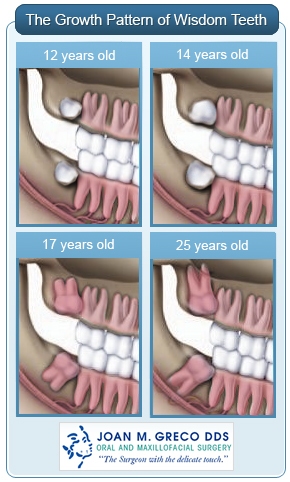Wisdom Tooth Removal
 By the age of eighteen, the average adult has 32 teeth: 16 teeth on the top and 16 teeth on the bottom. Each tooth in the mouth has a specific name and function. The teeth in the front of the mouth (incisors, canine and bicuspid teeth) are ideal for grasping and biting food into smaller pieces. The back teeth or molar teeth are used to grind food up into a consistency suitable for swallowing.
By the age of eighteen, the average adult has 32 teeth: 16 teeth on the top and 16 teeth on the bottom. Each tooth in the mouth has a specific name and function. The teeth in the front of the mouth (incisors, canine and bicuspid teeth) are ideal for grasping and biting food into smaller pieces. The back teeth or molar teeth are used to grind food up into a consistency suitable for swallowing.
The average mouth is made to hold only 28 teeth. It can be painful when 32 teeth try to fit in a mouth that holds only 28 teeth. These four other teeth are your Third Molars, also known as wisdom teeth.
Why Should I Remove My Wisdom Teeth?
Wisdom teeth are the last teeth to erupt. When they align properly and gum tissue is healthy, wisdom teeth do not have to be removed. Unfortunately, this does not generally happen. Wisdom teeth may grow sideways, or partially emerge from the gum, or even remain trapped beneath the gum and bone. When they are unable to properly erupt, it becomes necessary to extract them. Impacted teeth can take many positions in the bone as they attempt to find a pathway that allows them to successfully erupt.
Poorly positioned impacted wisdom teeth can cause many problems. When they are partially erupted, the opening around the tooth allows bacteria to grow. This will eventually cause an infection, which can result in swelling, stiffness, pain and illness. The pressure from the erupting wisdom tooth may move other teeth and disrupt the orthodontic or natural alignment of teeth. The most serious problem, however, occurs when tumors or cysts form around the impacted wisdom tooth, which results in the destruction of the jawbone and healthy teeth. Removal of the offending impacted tooth or teeth usually resolves these problems. Early removal is recommended to avoid future problems and to decrease the surgical risk involved with the procedure.

